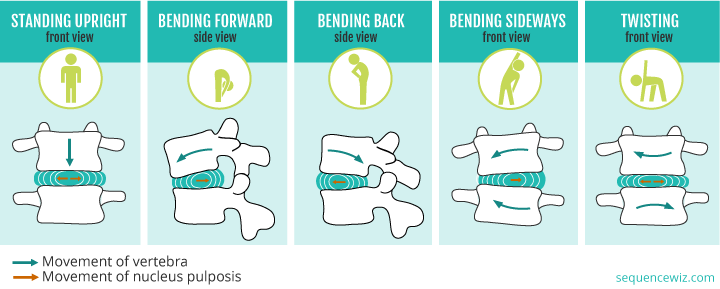I posted video of myself doing a pistol squat on each side but I also said that I never use them in my programs. Some of you may have wondered why so this little excerpt is here to explain my reasoning.
First of all, a pistol squat is a one leg squat where the bum goes right down to about 2 inches above the ground with your free leg being held straight out in front of you, parallel to the ground. See my video as a demonstration:
- Excessive spinal flexion
Google ‘pistol squat’ images and watch my video and you’ll see that in order to get ‘ass to grass’ (full depth) you need to curve your spine in a C shape. This spinal flexion is a demon for causing disc problems, especially in the lumbar (low back) region, because it compresses the front of your disc and pushes it back. tippmix kalkulàtor Repetitive motion in this way can lead to a herniated or bulging disc. Your strength coach will always ask you to keep a nicely flat back during lifts so that the vertebrae are stacked evenly on top of each other. This allows more even dispersal of the forces throughout your spinal column.

Taken from: http://sequencewiz.org/2013/08/14/rolling-up-from-a-standing-forward-bend-can-damage-your-spine/
- Stress on the hip flexors
The hip flexors sit around the front of your hip and are responsible for bringing your leg up in front of you. They can often be a source of issues for people because we already excessively use them if we sit a lot at a desk, which puts them in an unhappy shortened position. Cyclists and kayakers suffer doubly because their position has them constantly in a flexed hip position too.
The pistol squat requires your flexors (TFL/rectus femoris/psoas major) to be in a good working state so that you can hold your leg straight out in front of you. gaminátor Some people could struggle to do it for long even without squatting on the other leg as they will start to cramp!
- Stress on the patella tendon
The knee is a fickle joint and plenty of athletes and the general public will suffer from some knee complaint at one time or another. The patellar tendon (the tendon that all your quads run into that runs over your knee cap and finishes on your shinbone) is most often implicated in these problems. The pistol squat places a degree of strain on the tendon as it has a long distance to stretch out between where it starts and where it ends. Because tendons are different lengths between people (even people of the same height can have slightly different insertion points), some may suffer worse than others. The degree of tightness in your quads will also have an impact as they will be pulling up on the tendon if they’re not able to lengthen enough for the exercise.

Taken from: http://fitnesspainfree.com/a-deep-investigation-into-the-safety-and-performance-of-the-deep-squat-part-6-knee-health/
On top of that, if there is any sort of inflammation or weakness in that tendon, the joint or the bursae around it, the pistol squat is going to make things worse through compression of the joint. (The knee will also suffer if you’ve got any weakness in your hip muscles that cause knee valgus or weakness in your ankle joint that could cause over-pronation as you descend.)
- High reps/Load
In my first point I mention that it’s not great to have your spine in flexion. Specifically what I mean is that it’s not good to repeatedly put it under a high stress situation in flexion, which is what the pistol squat would do, especially if we were to start adding in a kettlebell! The body wants to experience movement in all directions and throughout all joints – you just need to be careful with how much, for how long and under what tension.
With any good program, a strength coach wants you to be able to perform high reps and to increase the load so that you’re consistently getting challenged. Performing high load, high rep pistol squats is a high-risk strategy and, to be frank, not worth the time or effort to get there!
So pistol squats may look like a ‘cool’ exercise but getting injured isn’t. The risks for this exercise far outweigh the potential rewards in my books. gaminator bonus code email
For all the reasons above, this is why at TOP the furthest we’d go is to a parallel thigh to ground.



Hi, this is a comment.
To get started with moderating, editing, and deleting comments, please visit the Comments screen in the dashboard.
Commenter avatars come from Gravatar.